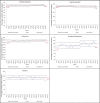Variation in the prevalence of urinary catheters: a profile of National Health Service patients in England
- PMID: 28645950
- PMCID: PMC5577876
- DOI: 10.1136/bmjopen-2016-013842
Variation in the prevalence of urinary catheters: a profile of National Health Service patients in England
Abstract
Introduction: Harm from catheter-associated urinary tract infections is a common, potentially avoidable, healthcare complication. Variation in catheter prevalence may exist and provide opportunity for reducing harm, yet to date is poorly understood. This study aimed to determine variation in the prevalence of urinary catheters between patient groups, settings, specialities and over time.
Methods: A prospective study (July 2012 to April 2016) of National Health Service (NHS) patients surveyed by healthcare professionals, following a standardised protocol to determine the presence of a urinary catheter and duration of use, on 1 day per month using the NHS Safety Thermometer.
Results: 1314 organisations (253 NHS trusts) and 9 266 284 patients were included. Overall, 12.9% of patients were catheterised, but utilisation varied. There was higher utilisation of catheters in males (15.7% vs 10.7% p<0.001) and younger people (18-70 year 14.0% vs >70 year 12.8% p<0.001), utilisation was highest in hospital settings (18.6% p<0.001), particularly in critical care (76.6% p<0.001). Most catheters had been in situ <28 days (72.9% p<0.001). No clinically significant changes were seen over time in any setting or specialty.
Conclusion: Catheter prevalence in patients receiving NHS-funded care varies according to gender, age, setting and specialty, being most prevalent in males, younger people, hospitals and critical care. Utilisation has changed only marginally over 46 months, and further guidance is indicated to provide clarity for clinicians on the insertion and removal of catheters to supplement the existing guidance on care.
Keywords: Adult urology; Urology; epidemiology.
© Article author(s) (or their employer(s) unless otherwise stated in the text of the article) 2017. All rights reserved. No commercial use is permitted unless otherwise expressly granted.
Conflict of interest statement
Competing interests: CV reports personal fees from Haelo during the conduct of the study and carries out occasional paid consultancy work on patient safety, though not related to this paper.
Figures





Similar articles
-
Epidemiology and health-economic burden of urinary-catheter-associated infection in English NHS hospitals: a probabilistic modelling study.J Hosp Infect. 2019 Sep;103(1):44-54. doi: 10.1016/j.jhin.2019.04.010. Epub 2019 Apr 30. J Hosp Infect. 2019. PMID: 31047934
-
Factors Associated With Healthcare-Acquired Catheter-Associated Urinary Tract Infections: Analysis Using Multiple Data Sources and Data Mining Techniques.J Wound Ostomy Continence Nurs. 2018 Mar/Apr;45(2):168-173. doi: 10.1097/WON.0000000000000409. J Wound Ostomy Continence Nurs. 2018. PMID: 29521928
-
[Urinary catheters prevalence study in a university hospital].Prog Urol. 2017 Apr;27(5):305-311. doi: 10.1016/j.purol.2017.03.006. Epub 2017 Apr 7. Prog Urol. 2017. PMID: 28392431 French.
-
Preventing catheter-associated urinary tract infections in the intensive care unit.Crit Care Clin. 2013 Jan;29(1):19-32. doi: 10.1016/j.ccc.2012.10.005. Crit Care Clin. 2013. PMID: 23182525 Review.
-
[Appropriate and inappropriate use of indwelling urinary catheters].Ned Tijdschr Geneeskd. 2012;156(37):A5052. Ned Tijdschr Geneeskd. 2012. PMID: 22971436 Review. Dutch.
Cited by
-
Regional variation in urinary catheter use in the Netherlands from 2012 to 2021: a population-based cohort.Ther Adv Urol. 2023 Nov 30;15:17562872231215181. doi: 10.1177/17562872231215181. eCollection 2023 Jan-Dec. Ther Adv Urol. 2023. PMID: 38046940 Free PMC article.
-
Revisiting the Frequency and Antimicrobial Resistance Patterns of Bacteria Implicated in Community Urinary Tract Infections.Antibiotics (Basel). 2022 Jun 3;11(6):768. doi: 10.3390/antibiotics11060768. Antibiotics (Basel). 2022. PMID: 35740174 Free PMC article.
-
Need to clamp indwelling urinary catheters before removal after different durations: a systematic review and meta-analysis.BMJ Open. 2023 Feb 15;13(2):e064075. doi: 10.1136/bmjopen-2022-064075. BMJ Open. 2023. PMID: 36792329 Free PMC article.
-
Transurethral Catheterization in Early Training: The Impact of Peer-Led Mentorship.Surg Res Pract. 2021 Oct 12;2021:8498835. doi: 10.1155/2021/8498835. eCollection 2021. Surg Res Pract. 2021. PMID: 34676281 Free PMC article.
-
Antimicrobial use in UK long-term care facilities: results of a point prevalence survey.J Antimicrob Chemother. 2019 Jul 1;74(7):2083-2090. doi: 10.1093/jac/dkz135. J Antimicrob Chemother. 2019. PMID: 30993326 Free PMC article.
References
MeSH terms
Grants and funding
LinkOut - more resources
Full Text Sources
Other Literature Sources
Medical
Molecular Biology Databases
Miscellaneous
